#middleware migration
Explore tagged Tumblr posts
Text
Explore the key business challenges in Middleware Migration and how Jade Global can help you modernize your Middleware Systems.
1 note
·
View note
Note
taking an educated guess, what would you say the likelihood is of posts/content/blogs being lost forever in this migration?
from what i understand this just affects the middleware, not the database that contains the posts and such, nor the UI. it's (presumably) going to look and act like tumblr but they're changing the tubes inbetween what you see and what gets saved to the database
128 notes
·
View notes
Text
Cloud Migration and Integration A Strategic Shift Toward Scalable Infrastructure
In today’s digital-first business environment, cloud computing is no longer just a technology trend—it’s a foundational element of enterprise strategy. As organizations seek greater agility, scalability, and cost-efficiency, cloud migration and integration have emerged as critical initiatives. However, transitioning to the cloud is far from a lift-and-shift process; it requires thoughtful planning, seamless integration, and a clear understanding of long-term business objectives.

What is Cloud Migration and Why Does It Matter
Cloud migration involves moving data, applications, and IT processes from on-premises infrastructure or legacy systems to cloud-based environments. These environments can be public, private, or hybrid, depending on the organization’s needs. While the move offers benefits such as cost reduction, improved performance, and on-demand scalability, the true value lies in enabling innovation through flexible technology infrastructure.
But migration is only the first step. Cloud integration—the process of configuring applications and systems to work cohesively within the cloud—is equally essential. Without integration, businesses may face operational silos, inconsistent data flows, and reduced productivity, undermining the very purpose of migration.
Key Considerations in Cloud Migration
A successful cloud migration depends on more than just transferring workloads. It involves analyzing current infrastructure, defining the desired end state, and selecting the right cloud model and service providers. Critical factors include:
Application suitability: Not all applications are cloud-ready. Some legacy systems may need reengineering or replacement.
Data governance: Moving sensitive data to the cloud demands a strong focus on compliance, encryption, and access controls.
Downtime management: Minimizing disruption during the migration process is essential for business continuity.
Security architecture: Ensuring that cloud environments are resilient against threats is a non-negotiable part of migration planning.
Integration for a Unified Ecosystem
Once in the cloud, seamless integration becomes the linchpin for realizing operational efficiency. Organizations must ensure that their applications, databases, and platforms communicate efficiently in real time. This includes integrating APIs, aligning with enterprise resource planning (ERP) systems, and enabling data exchange across multiple cloud platforms.
Hybrid and Multi-Cloud Strategies
Cloud strategies have evolved beyond single-provider solutions. Many organizations now adopt hybrid (combining on-premise and cloud infrastructure) or multi-cloud (using services from multiple cloud providers) approaches. While this enhances flexibility and avoids vendor lock-in, it adds complexity to integration and governance.
To address this, organizations need a unified approach to infrastructure orchestration, monitoring, and automation. Strong integration frameworks and middleware platforms become essential in stitching together a cohesive IT ecosystem.
Long-Term Value of Cloud Transformation
Cloud migration and integration are not one-time projects—they are ongoing transformations. As business needs evolve, cloud infrastructure must adapt through continuous optimization, cost management, and performance tuning.
Moreover, integrated cloud environments serve as the foundation for emerging technologies like artificial intelligence, data analytics, and Internet of Things (IoT), enabling businesses to innovate faster and more efficiently.
By treating cloud migration and integration as strategic investments rather than tactical moves, organizations position themselves to stay competitive, agile, and future-ready.
#CloudMigration#CloudIntegration#DigitalTransformation#HybridCloud#MultiCloud#CloudComputing#InfrastructureModernization#ITStrategy#BusinessContinuity
2 notes
·
View notes
Text
Top 10 Laravel Development Companies in the USA in 2024
Laravel is a widely-used open-source PHP web framework designed for creating web applications using the model-view-controller (MVC) architectural pattern. It offers developers a structured and expressive syntax, as well as a variety of built-in features and tools to enhance the efficiency and enjoyment of the development process.

Key components of Laravel include:
1. Eloquent ORM (Object-Relational Mapping): Laravel simplifies database interactions by enabling developers to work with database records as objects through a powerful ORM.
2. Routing: Laravel provides a straightforward and expressive method for defining application routes, simplifying the handling of incoming HTTP requests.
3. Middleware: This feature allows for the filtering of HTTP requests entering the application, making it useful for tasks like authentication, logging, and CSRF protection.
4. Artisan CLI (Command Line Interface): Laravel comes with Artisan, a robust command-line tool that offers commands for tasks such as database migrations, seeding, and generating boilerplate code.
5. Database Migrations and Seeding: Laravel's migration system enables version control of the database schema and easy sharing of changes across the team. Seeding allows for populating the database with test data.
6. Queue Management: Laravel's queue system permits deferred or background processing of tasks, which can enhance application performance and responsiveness.
7. Task Scheduling: Laravel provides a convenient way to define scheduled tasks within the application.
What are the reasons to opt for Laravel Web Development?
Laravel makes web development easier, developers more productive, and web applications more secure and scalable, making it one of the most important frameworks in web development.
There are multiple compelling reasons to choose Laravel for web development:
1. Clean and Organized Code: Laravel provides a sleek and expressive syntax, making writing and maintaining code simple. Its well-structured architecture follows the MVC pattern, enhancing code readability and maintainability.
2. Extensive Feature Set: Laravel comes with a wide range of built-in features and tools, including authentication, routing, caching, and session management.
3. Rapid Development: With built-in templates, ORM (Object-Relational Mapping), and powerful CLI (Command Line Interface) tools, Laravel empowers developers to build web applications quickly and efficiently.
4. Robust Security Measures: Laravel incorporates various security features such as encryption, CSRF (Cross-Site Request Forgery) protection, authentication, and authorization mechanisms.
5. Thriving Community and Ecosystem: Laravel boasts a large and active community of developers who provide extensive documentation, tutorials, and forums for support.
6. Database Management: Laravel's migration system allows developers to manage database schemas effortlessly, enabling version control and easy sharing of database changes across teams. Seeders facilitate the seeding of databases with test data, streamlining the testing and development process.
7. Comprehensive Testing Support: Laravel offers robust testing support, including integration with PHPUnit for writing unit and feature tests. It ensures that applications are thoroughly tested and reliable, reducing the risk of bugs and issues in production.
8. Scalability and Performance: Laravel provides scalability options such as database sharding, queue management, and caching mechanisms. These features enable applications to handle increased traffic and scale effectively.
Top 10 Laravel Development Companies in the USA in 2024
The Laravel framework is widely utilised by top Laravel development companies. It stands out among other web application development frameworks due to its advanced features and development tools that expedite web development. Therefore, this article aims to provide a list of the top 10 Laravel Development Companies in 2024, assisting you in selecting a suitable Laravel development company in the USA for your project.
IBR Infotech

IBR Infotech excels in providing high-quality Laravel web development services through its team of skilled Laravel developers. Enhance your online visibility with their committed Laravel development team, which is prepared to turn your ideas into reality accurately and effectively. Count on their top-notch services to receive the best as they customise solutions to your business requirements. Being a well-known Laravel Web Development Company IBR infotech is offering the We provide bespoke Laravel solutions to our worldwide customer base in the United States, United Kingdom, Europe, and Australia, ensuring prompt delivery and competitive pricing.
Additional Information-
GoodFirms : 5.0
Avg. hourly rate: $25 — $49 / hr
No. Employee: 10–49
Founded Year : 2014
Verve Systems
Elevate your enterprise with Verve Systems' Laravel development expertise. They craft scalable, user-centric web applications using the powerful Laravel framework. Their solutions enhance consumer experience through intuitive interfaces and ensure security and performance for your business.
Additional Information-
GoodFirms : 5.0
Avg. hourly rate: $25
No. Employee: 50–249
Founded Year : 2009
KrishaWeb

KrishaWeb is a world-class Laravel Development company that offers tailor-made web solutions to our clients. Whether you are stuck up with a website concept or want an AI-integrated application or a fully-fledged enterprise Laravel application, they can help you.
Additional Information-
GoodFirms : 5.0
Avg. hourly rate: $50 - $99/hr
No. Employee: 50 - 249
Founded Year : 2008
Bacancy
Bacancy is a top-rated Laravel Development Company in India, USA, Canada, and Australia. They follow Agile SDLC methodology to build enterprise-grade solutions using the Laravel framework. They use Ajax-enabled widgets, model view controller patterns, and built-in tools to create robust, reliable, and scalable web solutions
Additional Information-
GoodFirms : 4.8
Avg. hourly rate: $25 - $49/hr
No. Employee: 250 - 999
Founded Year : 2011
Elsner
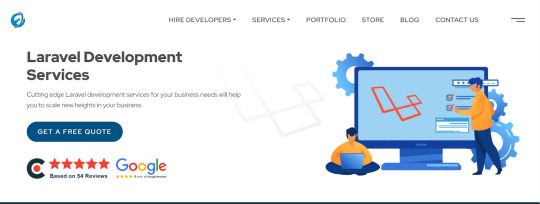
Elsner Technologies is a Laravel development company that has gained a high level of expertise in Laravel, one of the most popular PHP-based frameworks available in the market today. With the help of their Laravel Web Development services, you can expect both professional and highly imaginative web and mobile applications.
Additional Information-
GoodFirms : 5
Avg. hourly rate: < $25/hr
No. Employee: 250 - 999
Founded Year : 2006
Logicspice

Logicspice stands as an expert and professional Laravel web development service provider, catering to enterprises of diverse scales and industries. Leveraging the prowess of Laravel, an open-source PHP framework renowned for its ability to expedite the creation of secure, scalable, and feature-rich web applications.
Additional Information-
GoodFirms : 5
Avg. hourly rate: < $25/hr
No. Employee: 50 - 249
Founded Year : 2006
Sapphire Software Solutions
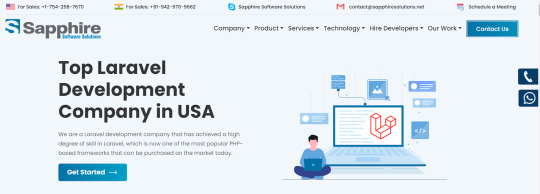
Sapphire Software Solutions, a leading Laravel development company in the USA, specialises in customised Laravel development, enterprise solutions,.With a reputation for excellence, they deliver top-notch services tailored to meet your unique business needs.
Additional Information-
GoodFirms : 5
Avg. hourly rate: NA
No. Employee: 50 - 249
Founded Year : 2002
iGex Solutions
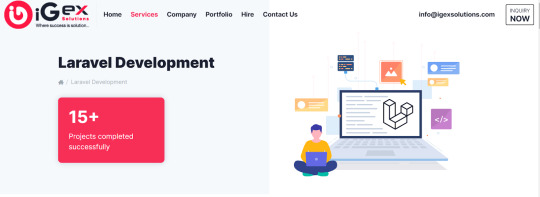
iGex Solutions offers the World’s Best Laravel Development Services with 14+ years of Industry Experience. They have 10+ Laravel Developer Experts. 100+ Elite Happy Clients from there Services. 100% Client Satisfaction Services with Affordable Laravel Development Cost.
Additional Information-
GoodFirms : 4.7
Avg. hourly rate: < $25/hr
No. Employee: 10 - 49
Founded Year : 2009
Hidden Brains
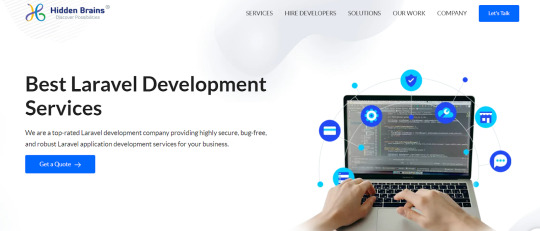
Hidden Brains is a leading Laravel web development company, building high-performance Laravel applications using the advantage of Laravel's framework features. As a reputed Laravel application development company, they believe your web application should accomplish the goals and can stay ahead of the rest.
Additional Information-
GoodFirms : 4.9
Avg. hourly rate: < $25/hr
No. Employee: 250 - 999
Founded Year : 2003
Matellio
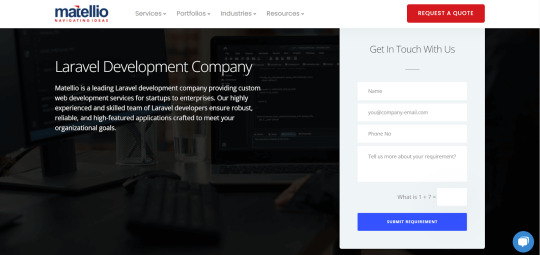
At Matellio, They offer a wide range of custom Laravel web development services to meet the unique needs of their global clientele. There expert Laravel developers have extensive experience creating robust, reliable, and feature-rich applications
Additional Information-
GoodFirms : 4.8
Avg. hourly rate: $50 - $99/hr
No. Employee: 50 - 249
Founded Year : 2014
What advantages does Laravel offer for your web application development?
Laravel, a popular PHP framework, offers several advantages for web application development:
Elegant Syntax
Modular Packaging
MVC Architecture Support
Database Migration System
Blade Templating Engine
Authentication and Authorization
Artisan Console
Testing Support
Community and Documentation
Conclusion:
I hope you found the information provided in the article to be enlightening and that it offered valuable insights into the top Laravel development companies.
These reputable Laravel development companies have a proven track record of creating customised solutions for various sectors, meeting client requirements with precision.
Over time, these highlighted Laravel developers for hire have completed numerous projects with success and are well-equipped to help advance your business.
Before finalising your choice of a Laravel web development partner, it is essential to request a detailed cost estimate and carefully examine their portfolio of past work.
#Laravel Development Companies#Laravel Development Companies in USA#Laravel Development Company#Laravel Web Development Companies#Laravel Web Development Services
2 notes
·
View notes
Text
You can learn NodeJS easily, Here's all you need:
1.Introduction to Node.js
• JavaScript Runtime for Server-Side Development
• Non-Blocking I/0
2.Setting Up Node.js
• Installing Node.js and NPM
• Package.json Configuration
• Node Version Manager (NVM)
3.Node.js Modules
• CommonJS Modules (require, module.exports)
• ES6 Modules (import, export)
• Built-in Modules (e.g., fs, http, events)
4.Core Concepts
• Event Loop
• Callbacks and Asynchronous Programming
• Streams and Buffers
5.Core Modules
• fs (File Svstem)
• http and https (HTTP Modules)
• events (Event Emitter)
• util (Utilities)
• os (Operating System)
• path (Path Module)
6.NPM (Node Package Manager)
• Installing Packages
• Creating and Managing package.json
• Semantic Versioning
• NPM Scripts
7.Asynchronous Programming in Node.js
• Callbacks
• Promises
• Async/Await
• Error-First Callbacks
8.Express.js Framework
• Routing
• Middleware
• Templating Engines (Pug, EJS)
• RESTful APIs
• Error Handling Middleware
9.Working with Databases
• Connecting to Databases (MongoDB, MySQL)
• Mongoose (for MongoDB)
• Sequelize (for MySQL)
• Database Migrations and Seeders
10.Authentication and Authorization
• JSON Web Tokens (JWT)
• Passport.js Middleware
• OAuth and OAuth2
11.Security
• Helmet.js (Security Middleware)
• Input Validation and Sanitization
• Secure Headers
• Cross-Origin Resource Sharing (CORS)
12.Testing and Debugging
• Unit Testing (Mocha, Chai)
• Debugging Tools (Node Inspector)
• Load Testing (Artillery, Apache Bench)
13.API Documentation
• Swagger
• API Blueprint
• Postman Documentation
14.Real-Time Applications
• WebSockets (Socket.io)
• Server-Sent Events (SSE)
• WebRTC for Video Calls
15.Performance Optimization
• Caching Strategies (in-memory, Redis)
• Load Balancing (Nginx, HAProxy)
• Profiling and Optimization Tools (Node Clinic, New Relic)
16.Deployment and Hosting
• Deploying Node.js Apps (PM2, Forever)
• Hosting Platforms (AWS, Heroku, DigitalOcean)
• Continuous Integration and Deployment-(Jenkins, Travis CI)
17.RESTful API Design
• Best Practices
• API Versioning
• HATEOAS (Hypermedia as the Engine-of Application State)
18.Middleware and Custom Modules
• Creating Custom Middleware
• Organizing Code into Modules
• Publish and Use Private NPM Packages
19.Logging
• Winston Logger
• Morgan Middleware
• Log Rotation Strategies
20.Streaming and Buffers
• Readable and Writable Streams
• Buffers
• Transform Streams
21.Error Handling and Monitoring
• Sentry and Error Tracking
• Health Checks and Monitoring Endpoints
22.Microservices Architecture
• Principles of Microservices
• Communication Patterns (REST, gRPC)
• Service Discovery and Load Balancing in Microservices
1 note
·
View note
Text
Learning ASP.NET Core Online: Tips for Fast-Tracking Your Skills
In the rapidly evolving tech world, staying ahead means continuously upgrading your skill set. Among the most in-demand frameworks today is ASP.NET Core, and mastering it can open doors to exciting development careers. For those ready to dive in, enrolling in an asp net core online course or committing to a structured ASP.NET Core training online can be your golden ticket.
Whether you're a complete beginner or transitioning from another framework, this article is your comprehensive guide to learning ASP.NET Core online efficiently. From structured strategies to tips that actually work, you’ll find everything you need here.
Why ASP.NET Core is Worth Learning
ASP.NET Core is a modern, high-performance framework developed by Microsoft for building cloud-based, internet-connected applications. It's open-source, cross-platform, and incredibly fast. With more companies adopting microservices architecture and container-based deployment, ASP.NET Core is increasingly at the forefront.
Power of ASP.NET Core in the Job Market
Many organizations are migrating their legacy .NET applications to ASP.NET Core to take advantage of its speed, scalability, and flexibility. Knowing this framework gives you a competitive edge in roles like backend developer, full-stack developer, and DevOps engineer.
Best Practices to Start Learning ASP.NET Core Online
1. Set Clear Goals
Before jumping into any online course, define what you want to achieve. Are you aiming for certification, job readiness, or just knowledge enhancement? Having a goal will help you choose the right course and maintain your motivation.
2. Choose Structured Learning Paths
A random collection of YouTube tutorials may not provide a comprehensive understanding. Instead, opt for a complete course structure that includes fundamentals, advanced topics, real-world projects, and assessments. Platforms offering certifications can also boost your resume.
3. Use Hands-On Projects to Practice
Theory alone won't help you master ASP.NET Core. Apply what you learn by building projects such as:
A blog or CMS
An eCommerce store
A RESTful API with Entity Framework
Microservices-based applications
These not only reinforce concepts but also enrich your portfolio.
Top Resources to Fast-Track Your Learning
1. Microsoft Learn
Microsoft's own documentation and learning paths are incredibly thorough. They are up-to-date, official, and cover everything from beginner to advanced topics.
2. Community Blogs and GitHub Repositories
Explore ASP.NET Core projects on GitHub. These repositories often include documentation, unit tests, and CI/CD integrations—valuable skills to learn alongside coding.
3. Enroll in a Quality ASP.NET Core Online Course
Platforms like ScholarHat offer courses tailored to fast-tracking your learning, complete with mentorship, projects, and quizzes. Their ASP.NET Core training online is structured to help learners become job-ready.
Common Mistakes to Avoid
1. Skipping Fundamentals
ASP.NET Core builds upon many essential concepts such as MVC architecture, dependency injection, middleware, and routing. Missing these can hinder your growth.
2. Not Writing Enough Code
Many learners spend too much time watching lectures without coding. Always supplement videos with active development time.
3. Ignoring Testing and Debugging
Good developers know how to test and debug effectively. Make use of xUnit, Moq, and built-in debugging tools in Visual Studio or Visual Studio Code.
Learning Path for Different Levels
Beginner Level
Learn C# fundamentals
Understand .NET basics
Explore MVC pattern
Build a simple CRUD application
Intermediate Level
Dependency injection
Middleware pipeline
Authentication & Authorization
Unit Testing & Debugging
Advanced Level
API development
Integrating with third-party APIs
CI/CD with Azure DevOps
Containerization with Docker
How to Stay Consistent and Motivated
1. Join Online Communities
Whether it’s Stack Overflow, Reddit, or Discord channels, connecting with fellow learners and professionals keeps you motivated.
2. Take Notes and Revisit Them
Create a personal knowledge base. This will help you during interviews and when revisiting concepts.
3. Track Your Progress
Platforms like ScholarHat provide progress tracking features in their courses. Seeing how far you've come keeps you moving forward.
Career Opportunities After Mastery
Learning ASP.NET Core opens doors to multiple career paths:
Backend Developer
Full Stack Developer
.NET Engineer
Cloud Application Developer
DevOps Engineer
In the middle of your learning journey, make sure to reflect on your progress and adjust your goals accordingly. It's crucial to keep your learning dynamic and project-driven.
Real-World Projects You Can Build
1. Expense Tracker Application
Use CRUD operations, authentication, and charting.
2. Hospital Management System
Implement REST APIs, database integration, and admin panels.
3. Microservice-Based eCommerce Platform
Integrate different services like cart, user, payment, and product services.
4. Portfolio Website
Utilize MVC, Entity Framework, and third-party APIs.
5. Social Media Clone
Create a scalable application with user posts, comments, likes, and notifications.
Conclusion: Fast-Track Your Growth Today
By strategically following the tips outlined above, you can accelerate your learning and build real-world competencies. Learning ASP.NET Core online: tips for fast-tracking your skills doesn’t just equip you with knowledge; it prepares you for success in the development world.
Start your journey today with a structured asp net core online course or a guided ASP.NET Core training online.
Frequently Asked Questions (FAQs)
What is the difference between .NET and ASP.NET Core?
.NET is the overall development platform, while ASP.NET Core is a web framework under .NET used specifically for building web applications.
Can I learn ASP.NET Core without prior coding knowledge?
It's recommended to know C# before diving into ASP.NET Core. It makes understanding the framework much easier.
How long does it take to master ASP.NET Core?
Depending on your pace, dedication, and previous experience, it may take 3 to 6 months.
Is ASP.NET Core open-source?
Yes, ASP.NET Core is completely open-source and maintained by Microsoft and the community.
What are the prerequisites for ASP.NET Core?
A solid understanding of C#, object-oriented programming, and web development basics is essential.
Which IDE is best for ASP.NET Core development?
Visual Studio and Visual Studio Code are both widely used and fully support ASP.NET Core.
Can ASP.NET Core be used for mobile app development?
Indirectly, yes—via APIs that support mobile frontends or with tools like Xamarin.
How do I deploy an ASP.NET Core application?
You can deploy it using Azure, Docker containers, or traditional hosting environments.
Is ASP.NET Core used in large-scale enterprise applications?
Yes, many large enterprises have adopted ASP.NET Core for its performance and scalability.
What certifications are available for ASP.NET Core?
Microsoft and other training platforms offer official certifications that validate your skills in ASP.NET Core.
1 note
·
View note
Text
Laravel Programming: A Comprehensive Guide
Table of Contents
Introduction to Laravel
Why Use Laravel?
Installing Laravel
Laravel Folder Structure
Routing and Controllers
Blade Templating Engine
Laravel Models and Eloquent ORM
Migrations and Database Seeding
Request Lifecycle and Middleware
Form Handling and Validation
Authentication and Authorization
Laravel Artisan CLI
RESTful API Development in Laravel
Testing in Laravel
Deployment and Performance Optimization
Laravel Ecosystem and Tools
Conclusion
1. Introduction to Laravel
Laravel is an open-source PHP framework built by Taylor Otwell. It follows the MVC (Model-View-Controller) architectural pattern, which promotes a clean separation between business logic, UI, and data.
Laravel aims to make development faster and easier by providing powerful tools such as:
Routing
Middleware
Authentication
Blade templating
ORM (Eloquent)
Queues
Artisan command-line tool
Laravel is currently one of the most popular PHP frameworks and powers thousands of web applications globally.
2. Why Use Laravel?
Benefits of Laravel:
Clean and Elegant Syntax: Laravel simplifies complex tasks.
MVC Architecture: Ensures separation of concerns.
Eloquent ORM: Elegant database abstraction layer.
Blade Templating: Lightweight yet powerful templating engine.
Built-in Authentication & Authorization: Secure and easy to implement.
Community and Ecosystem: Laravel has a rich ecosystem like Nova, Horizon, Forge, Envoyer, etc.
Testing Ready: PHPUnit integration for test-driven development (TDD).
0 notes
Text
The Three Main Cloud Service Models Explained: IaaS, PaaS, and SaaS
Cloud computing, which offers scalable and adaptable resources over the internet, has completely changed how businesses operate. At its core, cloud computing offers three primary Cloud Service Models: Infrastructure as a Service (IaaS), Platform as a Service (PaaS), and Software as a Service (SaaS). Each of these models serves to different business needs and helps organizations use technology without the burden of maintaining physical infrastructure.

As companies progressively migrate to the cloud, understanding these service models is essential. SaaS offers software solutions directly to users, PaaS improves application development and deployment, and IaaS supplies the fundamental infrastructure. Together, they form a comprehensive ecosystem that caters to diverse business functions.
Infrastructure as a Service (IaaS): Empowering Businesses with Flexibility
The cloud service model known as Infrastructure as a Service (IaaS) offers virtualized computer resources via the internet. IaaS allows companies to pay for networking, servers, storage, and other IT infrastructure on a pay-per-use basis. By enabling businesses to scale their infrastructure in response to demand, this concept lessens the need for large hardware capital expenditures.
Moreover, IaaS allows businesses to quickly deploy and manage applications without the hassle of physical installations. This flexibility not only saves time but also enhances agility, enabling companies to respond to market changes more effectively. As a result, IaaS is particularly beneficial for startups and enterprises looking to innovate without the constraints of traditional infrastructure.
Platform as a Service (PaaS): Simplifying Deployment and Development.
Platform as a Service (PaaS) offers a platform allowing developers to develop, test, and deploy applications without managing their own infrastructure.. PaaS provides a comprehensive environment that includes development tools, middleware, and database management, facilitating a streamlined development process.
With PaaS, the infrastructure, scaling, and security are taken care of by the service provider, allowing developers to concentrate on coding and innovation. This not only accelerates the development cycle but also fosters collaboration among development teams across different locations. The ability to quickly iterate and deploy applications makes PaaS a compelling choice for businesses aiming to enhance their software offerings.
Software as a Service (SaaS): Revolutionizing Accessibility and Collaboration
Software as a Service (SaaS) removes the need for individual device installations by delivering software applications via the internet. Users can access these applications via web browsers, ensuring that they are always using the latest version without manual updates. By improving accessibility, this paradigm enables teams to work together in real time from many locations.
SaaS applications are often subscription-based, which provides businesses with predictable costs and the ability to scale usage according to their needs. The convenience and ease of access to software solutions have made SaaS a preferred choice for many organizations, from small startups to large enterprises. As collaboration becomes increasingly important in today’s digital workplace, SaaS stands out as a key enabler of productivity.
Choosing the Right Cloud Model: Factors to Consider for Your Business
Choosing the right cloud service model depends on several factors, including business size, industry requirements, and specific operational needs. Organizations must assess their current infrastructure, budget constraints, and long-term goals to determine the most suitable model.
For instance, startups may benefit from IaaS for its flexibility as they scale, while established businesses with development teams might lean towards PaaS for faster application deployment. On the other hand, companies seeking hassle-free software solutions could find SaaS to be the best fit. Ultimately, understanding the unique advantages of each model will guide businesses in making informed decisions that align with their strategic objectives—potentially with the help of platforms like eShare.ai that simplify collaboration and cloud integration.
0 notes
Text
Sheerbit: The Top VoIP Development Company for Custom, Scalable Solutions
Introduction
In today’s fast-paced digital landscape, clear and reliable communication is no longer a luxury—it’s a business imperative. Voice over Internet Protocol (VoIP) technology has revolutionized how organizations connect, collaborate, and serve their customers. However, not all VoIP development companies are created equal. Selecting the right partner can mean the difference between a smooth deployment and ongoing technical headaches. This is where Sheerbit shines. As a leading VoIP development company, Sheerbit combines deep technical expertise, bespoke solutions, and unwavering customer support to deliver communication platforms that scale with your business.
Understanding VoIP and Its Business Impact
VoIP enables voice calls, video conferences, and multimedia data to traverse IP networks rather than traditional telephone lines. This shift reduces costs, boosts flexibility, and integrates seamlessly with cloud-based and on-premise systems. Organizations that adopt VoIP enjoy features such as advanced call routing, click-to-dial, call analytics, and integration with CRM or helpdesk platforms—empowering teams to work smarter and respond faster to customer needs.
Common Challenges in VoIP Deployments
Even with compelling benefits, VoIP projects can falter if not handled by seasoned professionals. Organizations often face:
Quality of Service (QoS) issues that lead to dropped calls or latency
Security vulnerabilities exposing voice traffic to eavesdropping or fraud
Complex integrations with legacy PBX systems or third-party applications
Scalability hurdles when call volume spikes or new offices come online
Ongoing maintenance and lackluster support after go-live
Addressing these challenges demands a partner who understands both the networking fundamentals and the unique needs of your business.
Why Sheerbit Stands Out
Sheerbit has built its reputation as the best VoIP development company by focusing on three core pillars: technical excellence, client-centric customization, and comprehensive support.
1. Technical Excellence
Every Sheerbit engineer brings extensive experience with leading VoIP platforms—Asterisk, FreeSWITCH, OpenSIPS, Kamailio, and WebRTC frameworks. Whether you need a robust SIP trunking solution or a cutting-edge WebRTC application, Sheerbit’s team writes clean, scalable code and adheres to industry best practices for network performance and reliability.
2. Custom VoIP Solutions
Off-the-shelf VoIP packages rarely fit every business scenario. Sheerbit specializes in tailor-made development services, from crafting custom dial plans and interactive voice response (IVR) systems to integrating advanced call-center features like predictive routing and real-time analytics. With Sheerbit, you can hire VoIP developers dedicated to understanding your workflows and delivering solutions that align perfectly with your objectives.
3. End-to-End Support
The deployment of a VoIP system is just the beginning. Sheerbit offers full-lifecycle services: consulting and needs assessment, architecture design, development, testing, deployment, and post-launch maintenance. Their DevOps-driven processes ensure seamless updates, continuous monitoring, and rapid resolution of any issues—minimizing downtime and safeguarding call quality.
Key Service Offerings
VoIP Development Services: Sheerbit engineers build feature-rich VoIP applications, including softphones, mobile VoIP apps, and web-based conferencing tools. They ensure interoperability across devices and browsers, delivering user experiences that mirror or exceed traditional phone systems.
Custom Integrations: Leverage your existing investments by integrating VoIP with CRMs like Salesforce or HubSpot, helpdesk platforms such as Zendesk, or bespoke databases. Sheerbit’s APIs and middleware ensure call data syncs accurately with your business systems.
SIP Trunking & PBX Migration: Whether you’re migrating from a legacy PBX to a modern SIP-based infrastructure or establishing new SIP trunks for international call routing, Sheerbit’s proven migration framework guarantees minimal service interruption.
Security & Compliance: Voice services must be secure. Sheerbit implements TLS/SRTP encryption, robust firewall configurations, and fraud-detection modules. They also assist with regulatory compliance (e.g., GDPR, HIPAA) to protect sensitive communications.
Success Stories
Global Retail Chain Enhances Customer Support A multinational retailer struggling with call center overload engaged Sheerbit to deploy a scalable Asterisk-based IVR with predictive call routing. Post-launch, average wait times dropped by 40%, and customer satisfaction scores rose significantly.
Healthcare Provider Integrates VoIP with EHR Sheerbit developed a HIPAA-compliant FreeSWITCH solution for a healthcare network, integrating audible call prompts directly into the electronic health record system. Clinicians saved an average of 10 minutes per patient, boosting operational efficiency.
How to Hire Sheerbit’s VoIP Developers
Engaging with Sheerbit is straightforward. After an initial consultation to assess your needs, you’ll receive a detailed proposal outlining scope, timelines, and pricing. You can choose to hire VoIP developers on a project basis or onboard them as part of your extended team. Flexible engagement models include fixed-price projects, time-and-materials contracts, or dedicated-team arrangements.
Pricing & Engagement Models
Sheerbit offers transparent, competitive pricing tailored to project complexity and resource requirements. Typical engagement tiers include:
Standard Package: Core VoIP deployment with essential features
Advanced Package: Custom development, integrations, and analytics
Enterprise Package: Full-scale solutions with ongoing support and SLAs
The Implementation Process
Discovery & Planning: Define objectives, technical requirements, and success metrics.
Design & Architecture: Create network diagrams, call-flow maps, and infrastructure plans.
Development & Testing: Build features in agile sprints, perform comprehensive QA, and conduct pilot testing.
Deployment & Training: Roll out the solution, configure networks, and train your IT staff and end users.
Support & Optimization: Provide 24/7 monitoring, periodic performance reviews, and iterative enhancements.
Conclusion & Call to Action
Selecting the best VoIP development company can transform your organization’s communications, delivering cost savings, operational agility, and superior customer experiences. With Sheerbit’s proven expertise in custom VoIP solutions, end-to-end support, and dedication to quality, your business is poised for seamless, future-ready communications.
Ready to elevate your voice infrastructure? Contact Sheerbit today to schedule a free consultation and discover how you can harness the power of a tailored VoIP solution built by industry experts.
0 notes
Text
Laravel Development Services Unlocking New Levels Of Efficiency

Laravel is a leading PHP framework favored for its elegant syntax and robust built-in tools. It streamlines web development by offering developers ready-made components and a clean, structured architecture. This combination makes building scalable and secure applications faster and more efficient.
Businesses increasingly turn to Laravel Development Services to accelerate project timelines without compromising on quality. Its intuitive features reduce complexity, allowing developers to focus on innovation rather than repetitive coding tasks. As a result, projects launch quicker and perform better.
In this blog, we'll explore how Laravel Development Services unlock new levels of efficiency. You'll learn about Laravel's core strengths and why expert developers make all the difference.
Architectural Advantages That Streamline Web Development
Laravel Development Services are built on a modular and maintainable architecture that helps simplify web development. The framework's structure supports cleaner code and seamless teamwork for faster, scalable results.
Clean MVC Structure
Laravel's MVC design keeps data, presentation, and business logic separate for better clarity and control. Developers can manage files independently, making the application more maintainable and modular. This speeds up development and enhances long-term flexibility.
Powerful Command-Line Tools
Laravel includes Artisan CLI, a powerful tool that automates tasks like migrations, testing, and code generation. It minimizes manual effort and repetitive work, giving developers more time to focus on building features. This leads to faster and more accurate outcomes.
Reusable Modular Code
With its package-based structure, Laravel allows developers to reuse components and modules across projects. This reduces development time and ensures consistency in the codebase. It also improves maintainability and supports easier future enhancements.
Faster Development Timelines with Laravel
Laravel makes project delivery quicker through streamlined workflows, built-in tools, and ready-made solutions. Laravel Development Services take advantage of these strengths to help businesses meet fast-paced digital demands.
Easy Database Management
Eloquent ORM simplifies working with databases using a clean, intuitive syntax. Developers can perform complex operations without writing extensive SQL queries. This saves time and makes data handling efficient and less error-prone.
Flexible Routing and Middleware
Laravel's routing and middleware system allows teams to manage app flows and logic with ease. Adding authentication, logging, and other features is fast and structured. This keeps development agile while enhancing control and security.
Fast Prototyping with Templates
Blade, Laravel's templating engine, supports quick and reusable front-end design creation. It separates code logic from visuals for more flexibility and reduced development time. Developers can quickly iterate on UI features without disrupting the backend.
Performance and Scalability for Growing Projects
Laravel's architecture ensures applications perform well under growing demands. Laravel Development Services optimize caching, queues, and modular features to maintain performance and prepare for scale.
Speed Boost with Caching
Laravel supports various caching systems to reduce load time and improve response rates. Caching helps deliver a smoother experience by avoiding repetitive processing. This efficiency is key for apps expecting high traffic and quick user interactions.
Smooth Background Jobs
Queues allow apps to handle large or slow tasks in the background, keeping the main process fast. This improves the overall user experience and system performance. It's especially useful in apps with email notifications, video processing, or imports.
Scalable by Design
Laravel's component-based structure enables apps to scale without full rewrites. New features or traffic spikes are handled through modular upgrades and optimized configurations. This makes Laravel ideal for businesses with growing digital ambitions.
Security and Stability That Saves Development Time
Laravel's built-in security features reduce the risk of bugs and vulnerabilities. Laravel Development Services focus on secure foundations to ensure development progresses smoothly without unexpected delays.
Built-In Security Protections
Laravel protects against SQL injection, XSS, and CSRF by default, reducing manual security implementations. This leads to a more secure app from the start and less time spent fixing bugs later. Developers can move forward with confidence.
Simple User Authentication
With Laravel's out-of-the-box authentication system, developers can implement login and access controls easily. It simplifies user management while maintaining robust protection. Customization options allow easy adaptation to specific needs.
Why Expert Laravel Services Improve Development Outcomes
Expert Laravel Development Services bring in deep technical know-how and strategic use of Laravel's advanced tools. This combination results in efficient project delivery, high performance, and long-term maintainability.
Mastering Advanced Features
Experienced developers utilize Laravel's advanced features like broadcasting, task scheduling, and event handling. These add interactive and automated capabilities to the application. With these tools, Laravel apps are faster, smarter, and more user-centric.
Avoiding Common Mistakes
Laravel has many tools, but misusing them can lead to bottlenecks. Experts follow coding standards, avoid shortcuts, and plan architecture wisely. This results in clean code, fewer bugs, and lower long-term costs.
Faster Project Completion
Skilled Laravel developers streamline every stage—from design to deployment. Their familiarity with tools like version control, testing libraries, and deployment pipelines accelerates work. This ensures your project is launched on time and runs smoothly.
Custom Laravel Development for Business-Centric Solutions
Laravel's flexibility allows it to be tailored to fit unique business goals. Laravel Development Services align the framework's capabilities with your operational needs to create solutions that are both efficient and effective.
Custom Performance Tuning
Laravel developers fine-tune databases, routes, and code to reduce latency and optimize output. This ensures high performance even during peak usage. Efficient tuning leads to faster apps and happier users.
Easy Third-Party Integrations
Laravel integrates well with APIs, CRMs, and external tools needed for modern digital operations. Developers can connect systems without creating new complexity. This streamlines workflows and accelerates business functionality.
Clean and Maintainable Code
Laravel developers follow coding practices that keep the project easy to update and extend. This helps avoid future rebuilds and keeps the codebase healthy. Clean code supports long-term savings and faster evolution.
Overcoming Complexities in Laravel Development
While Laravel simplifies many tasks, some complexities still require skilled handling. Laravel Development Services help businesses overcome technical hurdles smoothly to maintain project efficiency.
Handling Complex Data
Advanced projects often involve layered relationships and deep data hierarchies. Experts use Eloquent ORM wisely to structure databases that are both efficient and scalable. Proper planning reduces data slowdowns and improves reliability.
Staying Secure Always
Laravel helps enforce secure development practices, but continuous attention is still vital. Professional developers stay updated with new threats and implement preventative techniques. This keeps your application protected across its lifecycle.
Maintaining High Performance
As apps grow, so do performance needs. Experts manage load balancing, caching strategies, and asynchronous processes to maintain speed. This supports user satisfaction and smooth scaling.
Strategies to Maximize Laravel's Efficiency
Businesses can play a key role in accelerating Laravel development outcomes. These strategies ensure Laravel Development Services remain focused, aligned, and result-driven.
Clear Project Goals
Defining clear objectives helps developers build without distractions or confusion. This avoids costly revisions and ensures time is spent wisely. Well-set goals are crucial for speed and quality.
Open Communication
Regular discussions between stakeholders and developers reduce the risk of misalignment. Prompt feedback allows rapid iteration and fewer blockers. Strong communication ensures progress doesn't stall.
Leveraging Laravel Packages
The Laravel ecosystem includes powerful packages that solve common problems like SEO, payments, or testing. Using these packages saves time and improves code consistency. This leads to better results in less time.
Conclusion
Laravel Development Services combine speed, security, and flexibility—ideal for businesses that need reliable web development. When paired with skilled professionals, Laravel becomes a powerful asset for rapid project delivery. Whether you're building with Laravel or integrating it into WordPress and broader web development ecosystems, the framework ensures efficiency and scalability at every stage.
0 notes
Text

Enhancing Sales and Support with an AI-Powered CRM System
Introduction
In today’s competitive market, choosing the right customer relationship management software can be a game-changer. An AI-powered CRM not only stores your customer data but also uses smart automation to nurture leads, personalize outreach, and streamline support. By tapping into services like the OpenAI API, Twilio, and Zapier, you can connect all your tools and gain deeper insights, without overwhelming your team.
Benefits of Using an AI-Powered Customer Relationship Management System
1. Boosted Productivity through Intelligent Automation
With a modern customer relationship management system, routine tasks—data entry, follow-ups, and ticket routing—happen automatically. AI scans emails, logs details, and even suggests next steps so your team can focus on building genuine connections.
2. Delight Customers with Personal Touches
A good relationship management software remembers past purchases, preferred channels, and support history. AI analysis lets you send timely SMS updates via Twilio or tailor special offers based on each customer’s journey, turning one-time buyers into loyal fans.
3. Smarter Lead Scoring for Stronger Sales
Not all leads are equal. AI-driven CRMs rank prospects by engagement, demographics, and purchase signals—so your reps can spend time on the hottest opportunities. Over time, the system learns which patterns predict success, sharpening your pipeline and revenue forecasts.
4. Seamless Communication Workflows
By combining email-tracking features with Zapier automations, your CRM can alert managers when high-value prospects open messages or escalate urgent support tickets. Everything stays in one place, cutting down on dropped handoffs and missed follow-ups.
5. Data-Driven Insights and Forecasting
Beyond basic dashboards, an AI-powered tool predicts which regions—or products—are likely to outperform. Simply ask in plain English (thanks to OpenAI API integration), “Which sales team hit quota last quarter?” and get instant, personalized reports.
Top AI Features to Look for in CRM Software
Salesforce Einstein A leader in sales automation, Einstein uses built-in AI to score leads, forecast deals, and recommend your next best action.
HubSpot ChatSpot Its conversational AI chatbots handle FAQs, book meetings, and draft marketing emails—perfect for teams that want to work faster without coding.
monday.com CRM A no-code platform with visual boards and Zapier connections that simplify every workflow, from lead capture to post-sale support.
Challenges of Rolling Out an AI-Driven CRM
Data Quality & Privacy AI insights depend on clean, compliant data. Make sure you have consent workflows and GDPR-ready processes in place.
Integration Hurdles Migration from old systems can feel complex. Use middleware like Zapier to bridge gaps and avoid a big-bang switch.
Cost vs. Value Premium AI features and API calls (OpenAI API, Twilio messaging, etc.) come at a price. Start with a small pilot to prove ROI before scaling.
Keeping the Human Element Let AI handle repetitive tasks, but let your people handle nuanced conversations. That balance keeps interactions genuine.
Future Trends in AI-Powered CRMs
Voice & Sentiment Analysis: CRMs that flag frustrated callers or highlight upsell chances in real time.
Hyper-Personalized Recommendations: Dynamic product suggestions as unique as each customer.
Autonomous AI Agents: Virtual assistants that can book demos, draft proposals, or even provide triage support 24/7.
Conclusion
An AI-powered CRM system transforms how teams work and how customers feel. Whether you’re a MERN Stack development company building custom applications or seeking the best CRM software for large business pipelines, look for platforms that integrate the OpenAI API, Twilio, and Zapier. With smart automation, personalized engagement, and data-driven foresight, your organization can boost sales, elevate support, and build lasting relationships—without losing that essential human touch.
Visit :
https://justtrytech.com/mean-and-mern-full-stack-development/?utm_source=tumblr&ref=LUFFY0050025
#customer relationship management software#relationship management software#customer relationship management system#best crm software for large business#MERN Stack development company
0 notes
Text
Transform Your Business with Expert Digital Transformation Services
Founded in 2007, W3 Partnership provides solutions and services that help organizations make sense of their digital applications and services through integrated platforms and patterns. SMEs in their respective fields, our in-house integration consultants are specialists in IBM and MuleSoft products, and our cloud consultants and developers are experts in AWS and Azure. We design, develop, manage, and monitor such platforms. At W3 Partnership, we specialize in delivering integration connectivity as a service (iCaaS), cloud-based integration solutions, and middleware integration consultancy tailored to your unique needs.
Digital Transformation Services
Businesses can grow and develop in the digital age via digital transformation services to help them use technology to change their operations, customer experiences, and processes. Custom software development, cloud migration, process automation, collaboration tools, data analytics, and cybersecurity are just a few of the solutions that fall under this category. The objective is to bring about significant change in a number of business areas, which will improve customer experiences and increase agility and efficiency.
Digital Transformation Strategy
A digital transformation strategy is a detailed plan for using digital solutions to improve the physical aspects of your business across engineering, manufacturing, and service. Digital transformation is, in and of itself, a broad business strategy. The essential foundation is developing a roadmap for short—and long-term digital transformation, guided by business outcomes, not technology. Companies of all sizes see enviable business outcomes from digital transformation efforts, such as improving efficiency, maximizing revenue growth, and reducing operational costs.
Cloud Migration
This migration can involve various activities, including moving data storage, servers, applications, and entire IT infrastructures to the cloud. It is a crucial step for businesses looking to modernize their IT systems and take full advantage of the cloud's benefits, such as real-time processing, improved scalability, and on-demand resources. Cloud Migration is the Process of moving data, applications, and other business elements from on-premise infrastructure or traditional data centers to a cloud environment.
Check out this related blog-
0 notes
Link
#AIdevelopment#AISecurity#cloudcomputing#developertools#Enterprisetechnology#GoogleGemini#OpenAI#Workspaceautomation
0 notes
Text
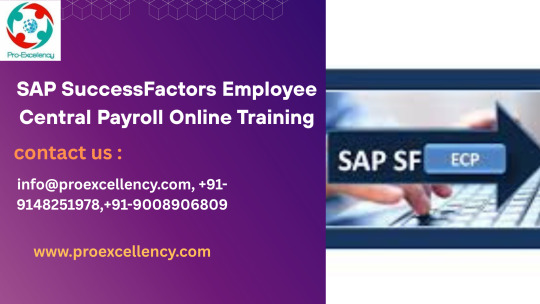
SAP SuccessFactors Payroll Online Training – ProExcellency Certified Course
SAP SuccessFactors Payroll Online Training With the rapidly changing landscape of HR technology in today's world, companies are quickly embracing cloud-based solutions to better manage global workforces. Of these, SAP SuccessFactors Employee Central Payroll (ECP) has become an effective tool to manage payroll operations across geographies in a compliant and streamlined manner. If you're an IT professional, HR consultant, fresher, or working professional seeking to develop a career in the in-demand field of SAP SuccessFactors Payroll, then ProExcellency's certified online course is your ideal launchpad. What is SAP SuccessFactors Employee Central Payroll? SAP SuccessFactors ECP is an in-cloud payroll engine that is also integrated with the Employee Central module. It enables businesses to process payroll in real-time, maintain global compliance, and streamline payroll activities with powerful automation capabilities. Unlike classic on-premise payroll systems, SuccessFactors Payroll takes advantage of cloud flexibility, simpler upgrades, and integration with other SAP SuccessFactors modules.
Why Learn SAP ECP? Payroll is the backbone of HR and financial processes. With the rise in migration away from SAP HCM on-premise solutions towards cloud-based platforms such as SuccessFactors, there is a high demand for talented SAP EC Payroll consultants familiar with the functional and technical aspects of payroll processing in the cloud. SAP ECP training not only increases your career opportunities but also leads to opportunities in global positions for SAP consulting, HRIS implementation, and payroll integration. ProExcellency's Online SAP ECP Training – Key Features ProExcellency is a reliable name for SAP training, providing industry-specific courses created by certified experts. Our SAP SuccessFactors Payroll Online Training is crafted to give an ideal mix of theoretical and practical expertise to ensure you are job-ready upon successful completion. What You'll Learn: SAP SuccessFactors and Employee Central Payroll architecture basics Basic payroll configuration and business rules SAP EC integration and middleware platforms such as SAP CPI and Boomi Payroll Control Center setup and operations Off-cycle payroll, retroactive payroll, and statutory compliance Payroll processing, error handling, and result verification Localization and global payroll scenarios Training Benefits: Live instructor-led training by seasoned SAP consultants 24/7 access to an SAP practice server dedicated to them Lifetime access to revised course material and session recordings Real-time case studies and project scenarios Interview preparation and resume-building assistance Certification guidance and post-training assistance Who Should Take This Course? This course is suitable for: SAP HCM professionals transitioning to cloud HR/payroll professionals aiming to move into SAP consulting Freshers looking to start a career in SAP SuccessFactors Technical consultants working on integrations and cloud-based solutions Whether you’re a beginner or have some SAP experience, the course is structured to build your knowledge from the ground up and gradually introduce advanced concepts and real-world applications. What Sets ProExcellency Apart? At ProExcellency, we realize that acquiring a system as intricate as SAP needs not only quality content but also expert guidance, hands-on exposure, and career development. That's why our philosophy is centered around interactive classes, scenario-based training, and ongoing support during your entire training process. Our trainers are certified SAP professionals with real-world experience in implementing global payroll on SAP, so you're learning from the ones who implement SAP on live projects. We've assisted hundreds of students upskill, become certified, and secure employment in leading organizations worldwide. When you sign up with ProExcellency, you're not merely enrolling in a course—you're investing in a career transformation.
[email protected], +91-9148251978,+91-9008906809
.
0 notes
Text
Integration of Inventory Software with ERP Systems: Benefits and Challenges
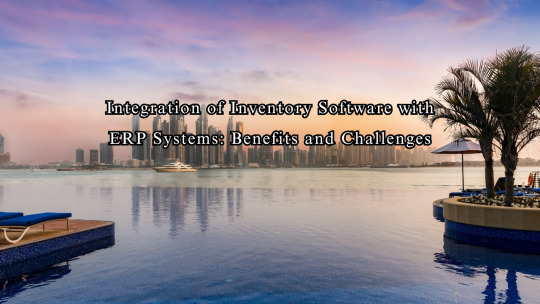
In today’s fast-paced business environment, efficiency and accuracy are critical for success—especially when it comes to managing inventory. Many businesses rely on Inventory Management Software to monitor stock levels, track goods movement, and streamline supply chains. However, the full potential of inventory tools is unlocked when they are integrated with Enterprise Resource Planning (ERP) systems.
This blog explores the key benefits and challenges of integrating inventory software with ERP systems, helping businesses make informed decisions on whether this integration is right for them.
What Is ERP and Inventory Software Integration?
Inventory Management Software handles stock control, order fulfillment, and warehouse operations. ERP systems, on the other hand, encompass broader business functions such as finance, HR, procurement, sales, and manufacturing.
Integration means linking your inventory system with the ERP so they work together in real time, sharing data across all departments. This eliminates data silos and creates a single source of truth for the entire organization.
Benefits of Integration
1. Real-Time Data Accuracy
When inventory data is automatically updated in the ERP system, everyone from sales to finance has access to accurate, up-to-date information. This minimizes errors caused by manual data entry or delayed reporting.
2. Enhanced Forecasting and Planning
Integrated systems allow businesses to analyze trends and generate accurate demand forecasts by combining inventory data with sales, marketing, and financial insights. This leads to smarter procurement decisions and reduced overstock or stockouts.
3. Streamlined Operations
Integration ensures that procurement, inventory, and finance functions are aligned. For instance, when stock reaches a reorder point, a purchase request can automatically be triggered in the ERP, speeding up the restocking process.
4. Improved Customer Satisfaction
Having real-time stock availability linked to your sales and e-commerce channels helps businesses fulfill orders faster and more accurately. This leads to fewer delays, reduced cancellations, and better customer experiences.
5. Reduced Operational Costs
Automation of inventory and ERP processes cuts down on manual work, reduces human error, and eliminates redundant systems. This results in cost savings and improved workforce productivity.
Challenges of Integration
1. Complex Implementation Process
ERP and inventory systems are both sophisticated platforms. Integrating them can be technically complex, requiring skilled IT support and careful planning to avoid downtime or data issues.
2. High Upfront Costs
Although integration can save money in the long run, the initial investment in terms of software, customization, and training can be significant—especially for small and medium enterprises.
3. Compatibility Issues
Not all inventory management software integrates seamlessly with all ERP systems. Businesses may need to invest in custom development or middleware solutions to bridge the gap.
4. Staff Training and Change Management
Employees must adapt to a new way of working, which may involve learning new systems or processes. Without proper training and change management, the integration may fail to deliver its expected benefits.
5. Data Migration Risks
Transferring historical inventory data into the ERP system can be risky if not handled correctly. Data mismatches or corruption can disrupt operations and affect decision-making.
Is Integration Right for Your Business?
If your business is experiencing rapid growth, struggling with manual inventory tracking, or dealing with inefficiencies across departments, integrating your inventory software with an ERP system can offer significant value.
Before proceeding, consider:
Your current pain points
Budget constraints
Internal IT capabilities
Vendor support for integration
Conclusion
The integration of Inventory Management Software with ERP systems offers powerful advantages: real-time data visibility, automation, better forecasting, and improved customer service. While there are challenges, proper planning and support can make the process smooth and successful.
As technology continues to evolve, this type of integration will become less of a luxury and more of a necessity for businesses aiming to stay competitive in today’s data-driven world
0 notes
Text
Understand the Oracle Java License Change and Maximize Savings with Oracle BYOL
In recent years, Oracle has made significant changes to how it licenses Java, a move that has caught many organizations off guard. The Oracle Java license change represents a strategic shift that affects how businesses access and use Java in their IT environments. At the same time, Oracle offers the Bring Your Own License (BYOL) model to help companies manage licensing costs while maintaining compliance. Understanding both the licensing changes and the BYOL model is crucial for IT leaders, developers, and procurement teams aiming to avoid unexpected costs and maintain operational efficiency.

Oracle Java License Change: What You Need to Know
Historically, Oracle provided Java under a free-to-use license model, primarily for personal and development purposes. However, starting in 2019, Oracle announced a new subscription-based model for commercial users of Oracle Java SE. Under this model, users are required to pay for updates, support, and the continued use of Java in production environments.
Then in 2023, Oracle made another update by introducing a new Java SE Universal Subscription, a per-employee license that bundles support for multiple versions and deployment types. This new subscription replaced the legacy per-processor or per-user pricing, and it now applies to all employees—not just developers or IT users. The goal was to simplify Java licensing, but for many organizations, it significantly increased costs and licensing complexity.
This Oracle Java license change has sparked widespread concern, especially among companies that were previously unaware of their licensing obligations or believed Java remained free for commercial use. Businesses now face the dual challenge of identifying where Java is deployed and determining whether those deployments fall under Oracle’s commercial licensing requirements.
The Risks of Non-Compliance
The Oracle Java license change means organizations must carefully audit their environments. Java is often deeply embedded in custom applications, middleware, and legacy systems. Without proper tracking, many businesses may be using Oracle Java without realizing they owe subscription fees. Oracle has been known to audit companies and impose hefty penalties for non-compliance.
Being proactive is essential. Organizations must inventory all instances of Java, distinguish between Oracle Java and open-source alternatives like OpenJDK, and determine whether they fall within the scope of the new licensing model. This audit process should be thorough, as even unintentional use of Oracle Java can lead to compliance issues.
Oracle BYOL: A Cost-Effective Alternative
As part of Oracle’s broader licensing strategy, the company offers a Bring Your Own License (BYOL) model. Oracle BYOL allows organizations to use their existing Oracle licenses when deploying in supported cloud environments, including Oracle Cloud Infrastructure (OCI) and certain third-party cloud providers.
For companies already invested in Oracle technologies, Oracle BYOL presents an opportunity to reduce costs and maximize ROI. It allows you to repurpose your on-premise licenses for cloud-based Java deployments, eliminating the need for redundant subscriptions. This flexibility can significantly reduce licensing expenditures while providing access to enterprise-grade support and features.
Notably, Oracle BYOL applies not just to Java but also to Oracle Database, WebLogic, and other middleware products. In the context of the Oracle Java license change, BYOL becomes an essential strategy for cloud migrations and hybrid IT models.
How to Use Oracle BYOL with Java
To take advantage of Oracle BYOL for Java, organizations must first ensure they have eligible licenses. These licenses must be covered under active support and compliance terms. Once verified, you can apply them to eligible cloud environments, reducing or eliminating the cost of additional Java subscriptions in those environments.

Here are key steps to implement Oracle BYOL effectively:
Conduct a License Review: Work with Oracle or a trusted licensing partner to review your existing entitlements.
Identify BYOL Opportunities: Determine where Oracle Java is deployed and whether those environments support BYOL.
Update Policies and Procedures: Ensure your procurement and IT teams understand the BYOL process and update documentation accordingly.
Monitor Usage: Implement tools to track license usage and ensure ongoing compliance.
When done correctly, Oracle BYOL can serve as a powerful tool to mitigate the financial impact of the Oracle Java license change.
OpenJDK: A Viable Alternative
In light of the license change, many organizations are also exploring alternatives to Oracle Java, such as OpenJDK. OpenJDK is a free and open-source implementation of the Java Platform, and it serves as the base for Oracle Java. Several vendors, including Amazon (Corretto), Red Hat, and Azul, provide enterprise-grade builds of OpenJDK, offering free updates and support options.
Switching to OpenJDK can help avoid licensing fees altogether. However, organizations should evaluate compatibility, performance, and support needs before making the transition. In some cases, sticking with Oracle Java and using Oracle BYOL may offer better support and stability, particularly for mission-critical systems.
Final Thoughts
The Oracle Java license change has reshaped how businesses manage their Java deployments. With Oracle now enforcing stricter licensing terms and pricing models, organizations must take a proactive approach to compliance. At the same time, the Oracle BYOL model offers a valuable path for reducing costs, especially for businesses moving to the cloud.
By understanding these changes and leveraging available licensing strategies, organizations can maintain operational continuity while controlling IT expenses. Whether you choose to remain with Oracle Java or migrate to OpenJDK, having a clear strategy in place is the best way to navigate the evolving Java ecosystem
0 notes